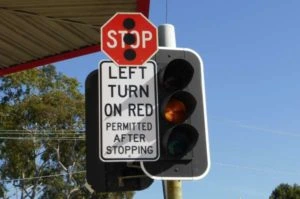One of the most nuanced aspects of driving is the ability to turn left at a red light, which deviates from normal traffic sign protocols.
This action is subject to specific rules and regulations, and its legality varies from jurisdiction to jurisdiction.
In this report, we delve into the complexities of turning left at a red light, exploring the legal aspects, potential dangers and the importance of responsible decision-making in this context.
Legal Framework: Understanding Traffic Laws
Allowing a left turn at a red light depends on the traffic regulations in force in the specific area. While some jurisdictions allow this maneuver under certain conditions, others strictly prohibit it. Drivers should be aware of local traffic regulations, including changes to left-turn rules at red lights. This basic understanding is essential to navigating intersections safely and legally.
Conditional Deductions: Navigation Statutory Exemptions
Areas where left turns are permitted often have certain conditions. Understanding the nuances of these exemptions is critical to responsible driving. For example, drivers can only allow left turns on red from a one-way street to another one-way street. Navigating the complexities of contingency benefits requires a thorough understanding of the special rules for turning left at red lights.
Intersection Dynamics: Challenges and Considerations
Turning left on a red light presents unique challenges related to intersection dynamics. Drivers must contend with oncoming traffic, pedestrian activity and potential blind spots. Negotiating these challenges requires heightened situational awareness and a careful assessment of the surrounding environment. Navigating intersections effectively is an important part of mastering a left turn at a red light.
Traffic Light Phases: Understanding Time
The timing of traffic light phases is a critical factor in the decision to turn left at a red light. Drivers should be aware of the sequence of signals, including the duration of a red light and the transition to a green light in oncoming traffic. Understanding traffic lights and timing ensures that drivers can make informed decisions about when it is safe and legal to turn left on red.
Pedestrian safety: Sharing an intersection
Pedestrian safety becomes paramount when considering a left turn at a red light. Drivers must be aware of the presence of pedestrians in the crosswalk and obey the right of way. The potential conflict between turning vehicles and pedestrians requires a careful and patient approach. Responsible decision-making in this context is to put pedestrian safety first and wait for the right moment to turn left.
Right-Turn Protocol: Traffic Flow Navigation
Understanding the right turn protocol is important in determining when it is appropriate to turn left at a red light. Yielding to oncoming traffic and maintaining a safe gap in the flow of vehicles is an integral part of responsible driving in this scenario. To navigate the intersection without disrupting the general flow of traffic, drivers must be patient and accommodating.
Safety Precautions: Risk Reduction
Although turning left on a red light may be legally permissible under certain conditions, drivers must put safety first. Reducing risks requires careful observation of the environment, effective use of mirrors and a willingness to yield when the situation calls for it. Adherence to defensive driving principles ensures that turning left at a red light is done with a focus on overall road safety.

Legal Consequences: Understanding Violations
Breaking the special rules for turning left at a red light can result in legal penalties. Violations can lead to traffic regulations, fines or increased insurance premiums. Drivers should be aware of the potential consequences of improperly performing this maneuver, reinforcing the importance of understanding and following local traffic laws.
Public awareness and education: promoting responsible driving
Because turning left at a red light is difficult, public awareness and education are important elements in promoting responsible driving behavior. Government agencies, driving schools and community initiatives play an important role in disseminating the legalities and best practices associated with this procedure. The training promotes a culture of informed decision-making among drivers and a safer road environment.
Conclusion:
In conclusion, turning left on a red light is a strategic driving practice that requires an understanding of traffic laws, intersection dynamics, and the nuance of the right turn. Drivers must go through the complex steps of determining conditional emission permits while prioritizing pedestrian safety and caution when performing this maneuver. Timing, situational awareness, and a commitment to responsible driving contribute to a successful and safe left turn at a red light. As roads evolve, the ability to make informed decisions in this context remains an important part of a driver’s skill set.
